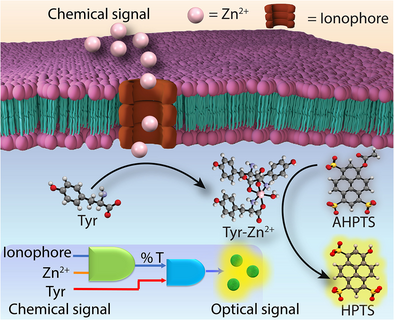Supramolecular Ion Channels to Engineer Zn2+ Ion Transport Mediated Chemical-to-Optical Signal Transduction
Graphical Abstract
Abstract
Artificial ion channels have significant potential for various applications, including molecular communication, bio-sensing, and constructing artificial cells. In this report, we demonstrated the development of a molecular communication system that transports ions across the lipid bilayers via the formation of supramolecular ion channels and harnesses chemical reactions to overcome the challenges of executing signal-processing functions at the molecular level. The potent ionophore self-assembles into nanochannels within the lipid bilayers and selectively transports Zn2+ ions. The movement of Zn2+ ions through these supramolecular ion channels enables the in situ generation of a water-soluble catalytic system with tyrosine. This catalytic system promotes esterase-like activity, generating fluorescent reporters from non-fluorescent ester-based compounds within the intravesicular environment. Furthermore, this process indicates the formation of a three-input AND logic gate in the fluorescence mode, allowing the monitoring of the chemical-to-optical signal amplification process akin to biological counterparts. Developing these molecular communication systems to replicate the complexity of natural cellular processes opens up exciting opportunities for designing advanced biomimetic tools and exploring the fundamental principles underlying cellular communication.
Conflict of Interests
The authors declare no conflict of interest.
Open Research
Data Availability Statement
The data that support the findings of this study are available in the supplementary material of this article.





